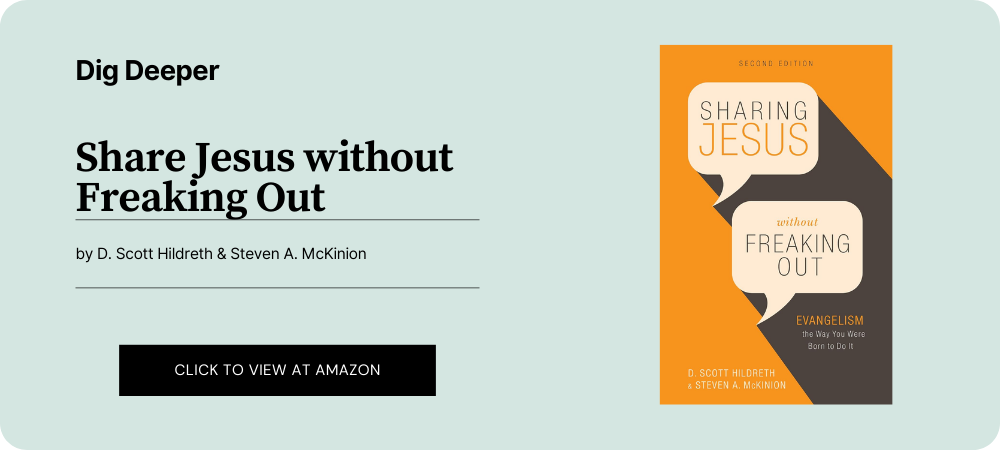This article has been a long time coming.
If you are a long-time follower of my writing (and I mean long time), you may recall an article I wrote back in 2015 titled, “A Word of Caution Concerning ‘Relationship Evangelism’.” In that article, I wrote about the widespread popularity of “relationship evangelism” among Christians as a better means of sharing the gospel with others. At the time, I expressed concerns with how this style of evangelism often plays out in the real world, while ultimately arguing it is an important tool for the tool belt.
Since the other article raised the concerns, this article raises the question: how do we do relationship evangelism well? Of course, a full answer to that question requires a book, like this one. There is much more than can be said here. Nevertheless, it’s time we get serious about relationship evangelism.
And that was my primary concern in the last article. Too often, the things we label as relationship evangelism are reactive instead of proactive. We know building relationships takes time, and it is easy to hide a lack of intentionality in that truth. We tell ourselves we are waiting until the right moment in the growth of a relationship, but in reality we may just be procrastinating. I fear much that we call relationship evangelism is heavy on building relationships and light on actually evangelizing. Perhaps we hope the other person will approach us about it.
So, how do we get serious about relationship evangelism? Here are four ideas that shift our posture from reactivity to proactivity and from procrastination to proclamation.
Out yourself as a Christian from the very beginning.
I mentioned this in the last article. It is really tempting to let a new relationship develop for a long time before we ever admit to being a Christian. Regardless of what you think counts as relationship evangelism, this isn’t it. The longer you wait to let them know about your identity in Christ, the harder it usually becomes to make a turn toward the gospel in normal conversation.
If your aim truly is to share the gospel, you need to let people know you are a Christian as soon as possible in a new relationship. In fact, make it happen in the first meeting if can. Of course, I’m not suggesting you lay out the plan of salvation after you shake their hand. I’m merely suggesting intentional relationship evangelism is built upon your identity in Christ, so your new friend needs to know that.
This could be as simple as bringing up where you go to church in the middle of an introductory conversation. For my students at the seminary, you have this one laid out on a platter. Simply let them know you’re a student preparing for Christian ministry. For some reason, I feel students often want to keep that fact reserved for a special occasion. That’s exactly backwards. In relationship evangelism, lean into that identity.
Map your relational network.
A second, crucial aspect of intentional relational evangelism is actually know which relationships you have in need of the gospel. I’m reasonably certain the majority of Christians I know have never listed out their lost friends on a sheet of paper.
Each of us have lists of relationships across a spectrum of social circles. In each one is another set of relationships. You have extended family; that’s a circle. You have neighbors; that’s a circle. You have colleagues; that’s a circle. If you have children, the parents of their schoolmates are a circle. You get the picture.
Listing the various circles in which you live, work, and play is a healthy exercise. The average person can usually think of five or six circles (family, neighborhood, work, hobbies, children, etc.). On a sheet of paper, create headings for each of these circles, and begin listing the relationships that exist in them. Place an asterisk by the ones you know are Christians.
When you see all the names without an asterisk, you’re looking at all the people who need you to share the gospel with them. Before long, you may see a network of people emerge, all of them in need of the gospel and all of them already in a relationship with you.
But we’re not done. You see those names with an asterisk? They are your partners in gospel proclamation. How can you include them in sharing with the other people in that circle? How can you follow their relationships into other networks? This is being proactive about relationship evangelism.
Track progress toward gospel acceptance.
Keeping track of your progress toward gospel proclamation and its acceptance is another important aspect of proactive relationship evangelism. Simply put, know how far down the path your friends are to hearing the gospel and then accepting the gospel.
Can you ensure that every friend who hears will accept the gospel? No. However, you can be faithful to share with them and gauge their receptivity over time. There are many different ways both to track progress and openness.
Consider keeping an evangelism log. That may sound silly, but it’s one of the most significant tools I’ve seen at demonstrating how much (or little) we are actually obedient to evangelism with those who have not heard or accepted. In fact, evangelism logs are often a prerequisite requirement in assessment for serving with international missions agencies.
Concerning the openness of those in your relational network, another simple concept is to assign one of three “lights” that vary based on their receptivity to the gospel: red, yellow, or green. As you can imagine, a red light is someone who is explicitly opposed to hearing about the gospel from you again. Yellow lights have not shut down your conversations, and green lights demonstrate an openness to hearing more.
Get to the gospel!
Finally, it’s not evangelism unless you get to the gospel. The three ideas above make it easier to turn toward the gospel with those in your relational network, but unless you take this last step, it will most likely never happen.
This may sound counterintuitive, but it’s not a bad idea to learn and practice some specific methods for sharing the gospel. Ironically enough, Christians often favor whatever they’ve defined as relational evangelism because it is “organic” and not based on presentations. I understand the desire for your explanation of the gospel to not feel canned. I agree with that desire. But if you are not comfortable sharing it in a clear way, the odds of you doing so in a relationship are slim. After all the work is put into a relationship for the sake of evangelism, you still have to know how to do the evangelism part.
First, make sure your relationships know you are a Christian. Next, know your network of relationships. Then, make sure you know where they are in their openness. Finally, get to the gospel!
May God be glorified in your obedience.







